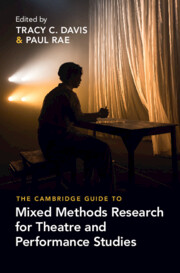Book contents
- The Cambridge Guide to Mixed Methods Research for Theatre and Performance Studies
- Reviews
- The Cambridge Guide to Mixed Methods Research for Theatre and Performance Studies
- Copyright page
- Contents
- Figures
- Tables
- Contributors
- Acknowledgements
- Introduction:
- Part I Planning
- Part II Doing
- Chapter 6 You’re Already a Digital Humanist:
- Chapter 7 Analysing Immersive Performance through Lived Bricolage
- Chapter 8 Talking Theatre in an Oral Culture:
- Chapter 9 Painful Fieldwork?
- Chapter 10 Fieldwork as Method in Theatre and Performance Studies
- Part III Interpreting
- Index
- References
Chapter 7 - Analysing Immersive Performance through Lived Bricolage
from Part II - Doing
Published online by Cambridge University Press: 01 February 2024
- The Cambridge Guide to Mixed Methods Research for Theatre and Performance Studies
- Reviews
- The Cambridge Guide to Mixed Methods Research for Theatre and Performance Studies
- Copyright page
- Contents
- Figures
- Tables
- Contributors
- Acknowledgements
- Introduction:
- Part I Planning
- Part II Doing
- Chapter 6 You’re Already a Digital Humanist:
- Chapter 7 Analysing Immersive Performance through Lived Bricolage
- Chapter 8 Talking Theatre in an Oral Culture:
- Chapter 9 Painful Fieldwork?
- Chapter 10 Fieldwork as Method in Theatre and Performance Studies
- Part III Interpreting
- Index
- References
Summary
This chapter draws on experiences of mixing methods in the interdisciplinary research of dance, choreography, immersive performance/participatory performance, and fandom. Reflecting on the methods employed in the author’s book Tandem Dances: Choreographing Immersive Performance, the chapter treats the research process as improvisational and compositional, emerging in tandem with the work being researched. These methods include audience research, choreographic analysis, participant observation, and analysing media content. The aim of the chapter is to make the research process explicit so other researchers might apply a similarly compositional approach in audience research in other performance contexts.
- Type
- Chapter
- Information
- Publisher: Cambridge University PressPrint publication year: 2024



